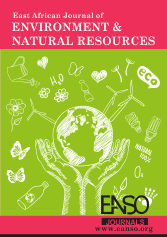Unpacking the Concept “Green Charcoal,” A Cooking Fuel Innovation: The Gulu University Interdisciplinary Experience
الملخص
Introduction: This paper reviews the concept of "Green Charcoal," drawing extensively on lessons learned from the UPCHAIN project implemented at Gulu University. Methodology: Based on research conducted by Work Package Two of the UPCHAIN project, complemented by a comprehensive literature review, this study examines the definitional ambiguities, practical challenges, and socio-environmental considerations inherent in developing sustainable charcoal alternatives within the unique context of Northern Uganda. Key results: The study defines Green charcoal as a clean, eco-friendly solid biofuel produced through the carbonisation or densification of biodegradable, carbon-rich organic waste materials such as agricultural residues, forestry by-products, and household waste using efficient, often mechanised, briquetting technologies. Historically, firewood and traditional charcoal have been the primary cooking fuels in the region, valued for their affordability and accessibility. Green charcoal is now emerging as a promising, sustainable alternative, marking a potential shift in the energy landscape. Households across both rural and urban settings commonly employ a combination of cooking fuels. There are vast definitions for green charcoal, coupled with acceptances and rejections. Conclusion: Most households in the region still depend on firewood and traditional charcoal because they are affordable and easy to get. Challenges in access and distribution, coupled with fierce competition from the informal traditional charcoal sector, complicate the widespread acceptance of green charcoal. Green charcoal has been embraced because of its environmental benefits (less deforestation), health advantages (less smoke), economic potential, and the availability of local raw materials. However, it's often rejected due to higher initial costs, being harder to light, producing more ash, not fitting traditional cooking methods, and inconsistent quality. Recommendations: Addressing affordability and accessibility gaps, integrate green charcoal with existing cultural norms and practices, integrating green charcoal with existing cultural norms and practices, and enhancing perceived value and usability.
التنزيلات
المراجع
Business in Cameroon Network (2023). UNDP empowers Maroua women with eco-friendly charcoal production unit. https://www.businessincameroon.com/environment/1212-13564-undp-empowers-maroua-women-with-eco-friendly-charcoal-production-unit?utm_source=chatgpt.com
Chidumayo, E. N., & Gumbo, D. J. (2013). The environmental impacts of charcoal production in tropical ecosystems of the world: A synthesis. Energy for Sustainable Development, 17(2), 86-94.
Kituyi, E. (2004). Towards sustainable production and use of charcoal in Kenya: exploring the potential in life cycle management approach. Journal of Cleaner Production, 12(8-10), 1047-1057.
Kumar, J. A., Kumar, K. V., Petchimuthu, M., Iyahraja, S., & Kumar, D. V. (2021). Comparative analysis of briquettes obtained from biomass and charcoal. Materials Today: Proceedings, 45, 857-861.
Kung, K. S., Rigu, S. W., Karau, S. K., Gachigi, K., & McDonald, L. (2015). Techno-economic feasibility of green charcoal production in Kenya. In Sustainable Access to Energy in the Global South: Essential Technologies and Implementation Approaches (pp. 87-100). Cham: Springer International Publishing.
Labeja, P. (2019). Government Drafts Roadmap for Universal Access to Clean Energy. In Uganda Radio Network. 23 October 2019. https://ugandaradionetwork.net/story/govt-drafts-road-map-for-universal-access-to-clean-energy?utm_source=chatgpt.com
Maes, W. H., & Verbist, B. (2012). Increasing the sustainability of household cooking in developing countries: policy implications. Renewable and Sustainable Energy Reviews, 16(6), 4204-4221.
Malak, K., De La Seiglière, C., Fernández, C., Swaminathan, M., Sebastián, A., & Arora, D. (2016). Green coal: A new energy source from leaves. Energy Procedia, 100, 484-491.
Ministry of Energy and Mineral Development (2023). The Energy Policy for Uganda 2023. https://memd.go.ug/wp-content/uploads/2020/07/Uganda2023-Energy-Policy-Review.pdf
Mwampamba, T. H., Owen, M., & Pigaht, M. (2013). Opportunities, challenges and way forward for the charcoal briquette industry in Sub-Saharan Africa. Energy for Sustainable Development, 17(2), 158-170.
Okello, S., Alidri, A., Mbazalire, E., Aoyo, C., Atube, F., Collins, O., & Okumu, C. N. (2024). Experiences with Green Charcoal: A Gender Consideration of Rural and Urban Households in Gulu District. East African Journal of Interdisciplinary Studies, 7(1), 423-429.
Pawaree, N., Phokha, S., & Phukapak, C. (2024). Multi-response optimization of charcoal briquettes process for green economy using a novel TOPSIS linear programming and genetic algorithms based on response surface methodology. Results in Engineering, 22, 102226.
Salma, A., Fryda, L., & Djelal, H. (2024). Biochar: a key player in carbon credits and climate mitigation. Resources, 13(2), 31.
UNDP (2013). Nationally Appropriate Mitigation Action Study on Sustainable Charcoal in Uganda. https://sdg.iisd.org/news/undp-study-outlines-nama-on-sustainable-charcoal-in-uganda/?utm_source=chatgpt.com
Wu, M., Wei, K., Jiang, J., Xu, B. B., & Ge, S. (2025). Advancing green sustainability: A comprehensive review of biomass briquette integration for coal-based energy frameworks. International Journal of Coal Science & Technology, 12(1), 1-26.
Yuan, X., & Gershenson, J. (2021, October). Analysis of Agricultural Waste Briquettes as a Sustainable Charcoal Substitute in Kenyan Markets. In 2021 IEEE Global Humanitarian Technology Conference (GHTC) (pp. 331-337). IEEE.
Yustas, Y. M., Tarimo, W. M., Mbacho, S. A., Kiobia, D. O., Makange, N. R., Kashaija, A. T., ... & Silungwe, F. R. (2022). Toward adaptation of briquettes making technology for green energy and youth employment in Tanzania: A review. Journal of Power and Energy Engineering, 10(4), 74-93.
Zanella, K., Concentino, V., & Taranto, O. P. (2017). Influence of the type of mixture and concentration of different binders on the mechanical properties of “green” charcoal briquettes. Chemical Engineering Transactions, 57, 199-204.
الحقوق الفكرية (c) 2025 Alidri Agatha, Francis Atube, Simon Okello, Christine Aoyo, Robert Ringitho, Collins Okello, Charles Okumu

هذا العمل مرخص حسب الرخصة Creative Commons Attribution 4.0 International License.




























